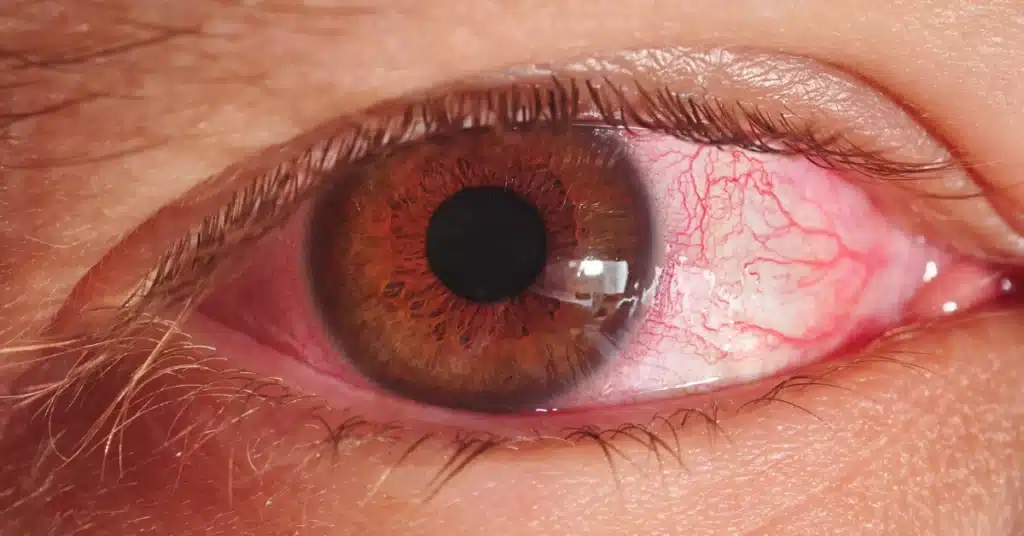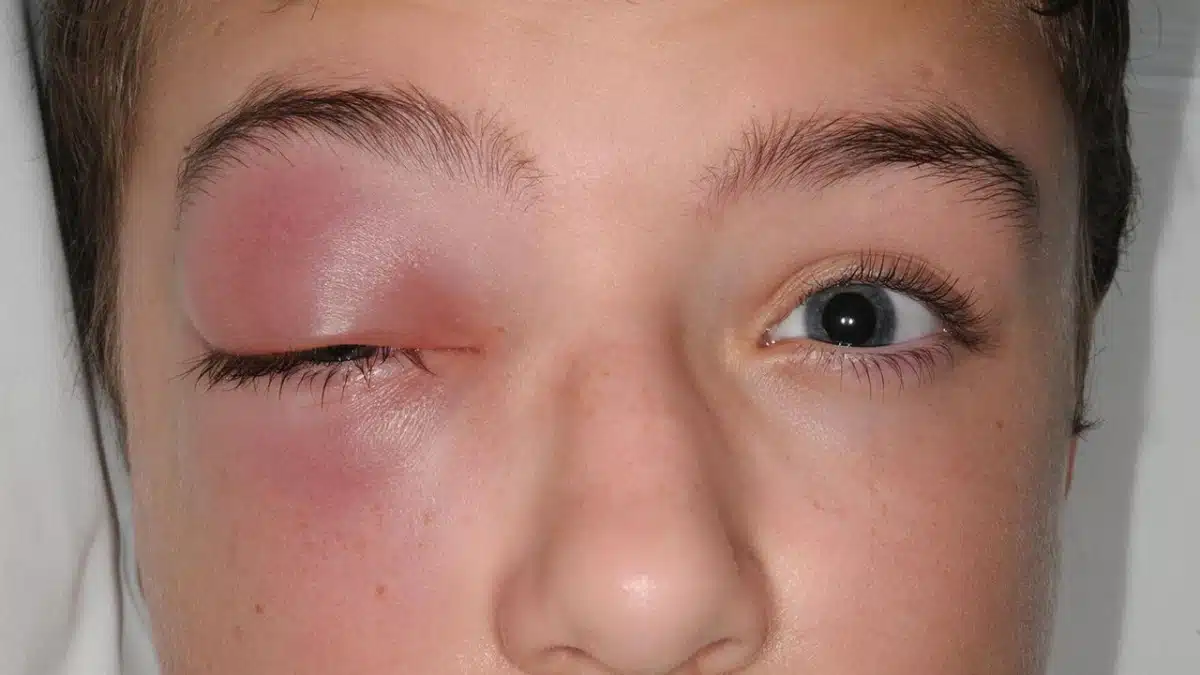Pink Eye (Conjunctivitis) and Periorbital Cellulitis are two eye diseases that can make the area around the eyes red and painful.
Even though they may have some symptoms in common, they are two different diseases with different causes and ways of treating them.
This article will talk about Pink Eye vs Periorbital Cellulitis so that you can understand these eye problems better and know when to see a doctor.
Pink Eye vs Periorbital Cellulitis: Causes
Pink Eye and Periorbital Cellulitis are very different due to the difference in reasons that cause them.
Bacterial Pink Eye is caused by bacteria such as Staphylococcus Aureus or Streptococcus Pneumoniae.
On the other hand, allergens like pollen and pet hair can cause allergic Pink Eye.
When it comes to viral Pink Eye, viruses like the Herpes Simplex Virus (HSV), Adenovirus, and Enteroviruses can cause viral Pink Eye.
Several factors, such as Sinus Infections, bug bites, face injuries, and dental surgery, cause Periorbital Cellulitis.
Periorbital Cellulitis is more common due to the frequent problem of Sinus Infections in people in winter.
Staphylococcus Aureus and Haemophilus Influenzae are two of the most common bacteria that cause Periorbital Cellulitis.
It is advised that you consult a doctor to treat your eye infections correctly.
Discover the various bacterias that lead to pink eye with our article: What Bacteria Causes Pink Eye? Know the Culprit Behind Bacterial Conjunctivitis
How Pink Eye symptoms differ from Periorbital Cellulitis
Pink Eye and Periorbital Cellulitis are both conditions that affect the eye, but their symptoms are very different.
Pink Eye can make your eyes itchy and red, and a mucus-like discharge is noticeable.
Sometimes, you may also feel sensitive to light. Periorbital Cellulitis, on the other hand, makes your eyes red, puffy eyes that often hurt, and causes fever.
When you have Pink Eye, the inflammation is limited to the cornea. Contrastingly,Periorbital Cellulitisspreads to the tissues around your eyes.
It is very important to know the difference between these two conditions for quick treatment.
Know everything about pink eye discharge with our article: Is Pink Eye Discharge Normal: What You Need to Know
Pink Eye vs Periorbital Cellulitis: treatment
 Source: dtimiraos_from_Getty_Images
Source: dtimiraos_from_Getty_ImagesPink Eye and Periorbital Cellulitis are both eye diseases that can be treated.
Your Pink Eye treatment depends on the type of Conjunctivitis you have. If someone has a bacterial Pink eye, medicines can help ease the symptoms.
People allergic to Pink Eye may need antihistamines or vasoconstrictor eye drops to feel better.
However, treatment for viral Pink Eye is very different. Even though it usually goes away independently, it is still best to see a doctor for the best advice and care.
In the same way, medicines are often suggested to help people with Periorbital Cellulitis feel better.
For better care and to avoid complications, Intravenous (IV) treatments are the most common path recommended for treating Periorbital Cellulitis.
Remember, consulting a qualified eye doctor on how to treat both these eye conditions effectively is essential.
| Characteristic | Periorbital Cellulitis | Pink Eye |
|---|---|---|
| Causes | Sinus infections, bug bites, face injuries, bacterial infections (e.g., Staphylococcus Aureus, Haemophilus Influenzae) | Bacteria (bacterial Pink Eye), allergens (allergic Pink Eye), viruses (viral Pink Eye) |
| Symptoms | Red, swollen, painful eyes, fever | Redness, itching, mucus-like discharge, sensitivity to light |
| Treatment | Typically requires intravenous (IV) treatments, antibiotics | Treatment varies based on the type (bacterial, allergic, viral), may involve medications or antihistamines, or may resolve on its own |
Conclusion
In conclusion, understanding Pink Eye vs Periorbital Cellulitis is crucial for choosing the right and effective treatment.
These two eye conditions may have some symptoms in common, but the difference in their causes and treatment options sets them apart.
Pink Eye occurs due to bacteria, allergens, or viruses, leading to redness, itching, and discharge from the eye.
Periorbital Cellulitis is often associated with factors like Sinus Infections or facial injuries swollen, painful eyes accompanied by fever.
Treatment varies, with antibiotics often recommended for Periorbital Cellulitis and tailored remedies for different types of Pink Eye.
Seeking guidance from a qualified eye doctor is essential for the best care when dealing with Pink Eye vs Periorbital Cellulitis.
Frequently Asked Questions
What are the common causes of Pink Eye?
Pink Eye can be caused by bacteria (bacterial Pink Eye), allergens (allergic Pink Eye), or viruses (viral Pink Eye).
What are the primary causes of Periorbital Cellulitis?
Sinus infections, bug bites, face injuries, and dental surgery can cause Periorbital Cellulitis. Bacterial infections, including Staphylococcus Aureus and Haemophilus Influenzae, are common culprits.
How do the symptoms of Pink Eye differ from those of Periorbital Cellulitis?
Pink Eye symptoms include redness, itching, and mucus-like discharge. At the same time, Periorbital Cellulitis manifests as red, swollen, painful eyes and may lead to fever. Pink Eye affects the cornea, whereas Periorbital Cellulitis spreads to the surrounding tissues.
What are the treatment options for Pink Eye?
The treatment options for Pink Eye depend on its type. Bacterial Pink Eye may require medications, while allergic Pink Eye may be alleviated with antihistamines or vasoconstrictor eye drops. Viral Pink Eye typically resolves independently, but consulting a doctor is recommended.
How is Periorbital Cellulitis treated?
Treatment for Periorbital Cellulitis often involves intravenous (IV) treatments to help ease the symptoms and prevent complications. Consulting a qualified eye doctor is crucial for effective care.
When referencing outside resources, GoodrxMedicine always provides full citations. To learn more about the measures we use to maintain the quality of our content, please review our Content Information Policy.










